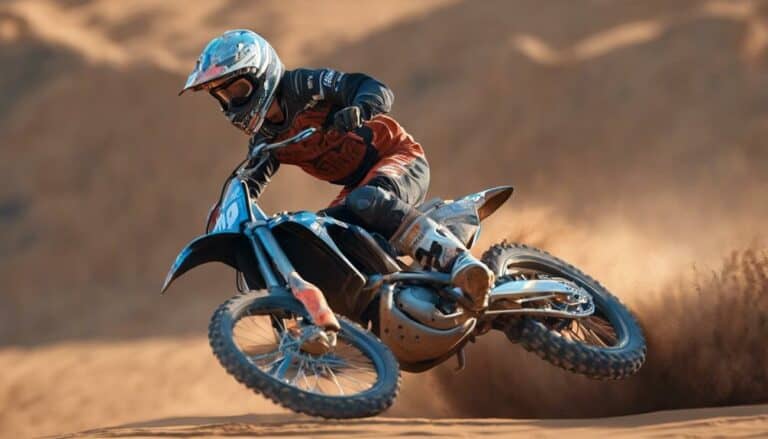When it comes to improving your dirt bike jumping skills, you need to pay close attention to a few critical factors that can make all the difference in your performance.
From mastering the art of controlling your bike mid-air to understanding the importance of body positioning, each element plays a pivotal role in elevating your skills to the next level.
But what truly sets apart the average jumpers from the exceptional ones? Let's explore the key factors that can help you soar to greater heights in your dirt bike jumping journey.
Key Takeaways
- Maintain balance and stability by keeping weight centered and gripping the bike with knees.
- Manage speed and timing accurately to achieve optimal height and distance.
- Ensure proper bike setup and maintenance for enhanced performance during jumps.
- Practice regularly to build muscle memory, refine technique, and adapt to different terrains.
Proper Body Positioning
To maximize your dirt bike jumping skills, the proper body positioning is essential for maintaining balance, control, and agility in the air. When approaching smaller jumps, focus on positioning your body correctly. Keep your body upright, with your weight centered over the bike and the front tire. Bend your knees to absorb the impact upon takeoff, allowing for better maneuverability in the air. Gripping the dirt bike firmly with your knees will provide guarantee, preventing any chance of sliding off during the jump.
As you soar through the air, concentrate on your upper body positioning. Keep your head over the handlebars to provide proper weight distribution. Additionally, maintain your elbows up, aiding in control and allowing for quick adjustments while airborne. Practice these techniques diligently to perfect your landing and maintain control throughout the jump. By honing your body positioning skills, you'll gain confidence and mastery in your dirt bike jumping abilities.
Speed and Timing Control
Mastering speed and timing control is key to achieving maximum jumps on your dirt bike. To excel in this aspect, focus on the following:
- Timing: Hit the jump at the precise moment to optimize height and distance.
- Speed Control: Match your speed to the jump's requirements for a smooth takeoff and landing.
- Distance Adjustment: Adjust your speed and timing according to the jump's size and shape.
- Practice Variety: Experiment with different speeds and timings on various jumps to enhance your skills.
- Consistency: Maintain consistent speed and timing for better control and successful jumps.
Bike Setup and Maintenance
For perfect dirt bike jumping performance, ensuring your bike is properly set up and maintained is paramount. When it comes to bike setup and maintenance, attention to detail can make a significant difference in your jumping skills. Here are some key factors to focus on:
| Bike Setup | Maintenance | Importance |
|---|---|---|
| Tire Pressure | Check regularly | Handling |
| Suspension Settings | Adjust as needed | Stability |
| Chain Tension | Keep it best | Power Transfer |
Checking your tire pressure, adjusting suspension settings, and maintaining proper chain tension are crucial for maximizing your bike's performance. These elements not only enhance handling and stability during jumps but also ensure a smoother power transfer. Additionally, keeping your bike in good condition and consulting with experts can prevent accidents and optimize your jumping experience. Remember, a well-tuned bike can be the key to optimizing your full potential on the track.
Practice and Repetition
Regularly practicing jumping on dirt bikes is essential for building muscle memory and honing your technique to improve your skills. Repetition is the key to mastering jumps and gaining confidence in your abilities. Consistent practice helps riders understand the timing and speed required for different jumps. Repeating jumps allows riders to refine their body positioning and landing techniques. Regular practice sessions are essential for advancing your dirt bike jumping skills effectively.
- Muscle Memory: Practice helps your muscles remember the movements required for successful jumps.
- Technique Refinement: Repetition allows you to perfect your jumping technique over time.
- Timing Mastery: Consistent practice aids in mastering the timing needed for different types of jumps.
- Speed Control: Regularly jumping helps you control your speed to tackle jumps more effectively.
- Body Positioning: Practice allows you to fine-tune your body positioning for best jumps.
With dedication to practice and repetition, you can elevate your dirt bike jumping skills to new heights.
Understanding Terrain and Obstacles
To excel in improving your dirt bike jumping skills, understanding the terrain and obstacles on the track is pivotal. Terrain analysis is vital as different terrain variations like bumps, ruts, or berms can greatly impact your jumping techniques.
When approaching jumps, adapt your technique based on the specific track features to guarantee a smooth and successful jump. Obstacles such as rocks, logs, or jumps require careful planning and precise execution to navigate through them effectively.
By practicing on diverse terrains, you can enhance your adaptability and skill development in jumping over various obstacles. Engage in practice drills that simulate different track conditions to refine your jump approach and overall performance.
Conclusion
You've learned the key factors to focus on when enhancing your dirt bike jumping skills. Remember, mastering proper body positioning, controlling speed and timing, maintaining your bike, practicing consistently, and understanding terrain are vital for success.
Did you know that 80% of dirt bike jumping accidents occur due to improper body positioning and lack of skill? By honing these skills, you can't only improve your jumping abilities but also stay safe on the track.
Keep pushing yourself to new heights!

